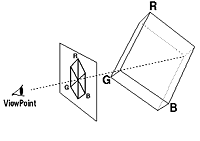Whitepapers
IS THE COLOR INFORMATION THREE DIMENSIONAL?
Two different instruments are commonly used for measuring and evaluating color television signals; the Waveform Monitor and the Vectorscope.
The signals representing bright objects in a TV picture are shown in the upper portion of a Waveform Monitor screen and signals representing dark objects reside in the lower portion of the screen. Heavily-saturated colors are displayed as dots lying close to the edge of a Vectorscope screen, and minimally saturated colors appear near the center of the scope. Also, the angular position of the dots represent the hue of each dot.
Why are two different instruments needed to measure color in a video signal? The reason is that the color information is three-dimensional. Each of the above instruments displays the information in a two dimensional field; neither of the two can handle and display the three-dimensional aspects of color information. Waveforms displayed on the Waveform Monitor do not indicate if the color is red or blue, for example. Dots displayed on the Vectorscope screen do not tell if they represent dark green or bright green.
Similarly, the relative positions of two objects in the space are difficult to define from one view-point. Two stars in the night sky, for example, may look very close to each other, but one could be thousands of light years closer to us than the other. To actually determine the distance between the two stars, they must be observed from another, more advantageous point.
While the Waveform Monitor and the Vectorscope show the color information as seen from only one direction, a three-dimensional display process can be derived using 'virtual reality' technology. This would allow the user to view color information in a virtual three-dimensional space.
Any color can be made by mixing three primary colors, R (red),G (green), and B (blue). By assigning these R, G, and B values to the X, Y, and Z axes, respectively, a color is represented by a point located within the XYZ space. Black, for example, is shown as a point almost on the origin point of the XYZ space because each color component, R,G or B, for black is 0. Yellow, which consists of red and green, with no blue component, is placed at a far diagonal position from the origin of the XY plane. By using this virtual 3D colorspace monitor, any color may be displayed and measured for its brightness, saturation, and hue at one time. But, to evaluate colors located in remote areas within the XYZ space, you may have to walk through the XYZ space.
The vectorscope displays color information as seen from one particular point within the above XYZ space, that is, the origin that actually represents the color black. Because the vectorscope looks up the color along an imaginary axis between the origin (representing black) and a spatial point representing the color white (which has 100% each of the R, G, and B components), black and white collide and cannot be differentiated from one another. This is the reason why three dimensional color information cannot be measured properly on a monitoring instrument that has only a one or two-dimensional display(Figure 7).

Figure: 7 Color information viewed from a certain angle (back)
In the video industry, this process is called a "chromakey"(Figure 1) and the matte signals are created by converting the hue difference of the R, G, and B signals to an amplitude differential. Matte signals are then applied to the gate input of the switcher to create the compositing effect.
This same process can be used on computer generated imagery by processing the digitized picture.
The quality of a composite image depends on whether a precise and identical matte image can be achieved for the foreground object. For example, let's consider a magenta and a red foreground object shot in front of blue screen. Magenta contains a bluish color component, so the difference of hue achieved is smaller than that from the red object. Since the key value also varies, it makes it difficult to get a clean matte image for each of the red and magenta objects using the same conditions. Blue-spill removal from the edges of the foreground object and creating mattes from translucent objects, like smoke or steam, are among the most difficult conditions that must be resolved for clear composited images.

